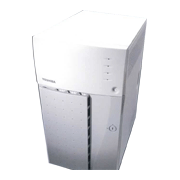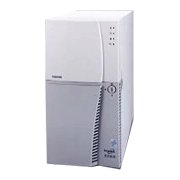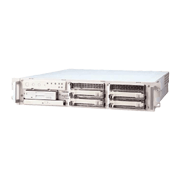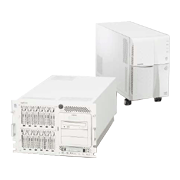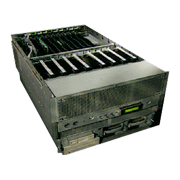Toshiba introduced the MAGNIA series of PC servers in 1998 to replace the GS series. The series consisted of mid-range models — the MAGNIA 5000 announced in June 1998, the MAGNIA 7000 in July 1998, the MAGNIA 5100 in March 1999, the MAGNIA 7010 in June 1999, the MAGNIA 7010FR in September 1999, and the MAGNIA 7100 in June 2000; entry-level models — the MAGNIA 3000 announced in June 1998, the MAGNIA 3010 in March 1999, the MAGNIA 3020 in November 1999, the MAGNIA 3030 in December 1999, the MAGNIA 3035R in June 2000, and the MAGNIA 3100 in August 2000; and compact entry-level models — the MAGNIA LiTE10 announced in January 1999, the MAGNIA LiTE20 in November 1999, and the MAGNIA LiTE21 in November 2000. Unlike the GS series, the MAGNIA series also included a high-end model, the MAGNIA 9000 announced in October 1999.
As with the GS series, Toshiba concentrated on scalability and high reliability for the MAGNIA series, which it expected would be used for mission-critical system applications. To provide scalability, the MAGNIA servers were implemented with symmetric multiprocessing with one to eight CPUs. For increased reliability, the MAGNIA series introduced LAN card redundancy in addition to the features found on the GS series: namely, power-supply redundancy, RAID disks, server monitoring features, and cluster configurations with failover functionality. The MAGNIA 7010FR, like the GS700FR, was supplied with a quick rollback function, a technology to avoid system crashes (called the Super Fault Resilient (SFR) function on the GS700FR).
Having redundant power-supply units meant the servers could avoid interrupting system operations when a power-supply unit failed, but also allowing hot swapping of power-supply units meant faulty units could be replaced without interrupting system operations.
The MAGNIA models were supplied with RAID 0, RAID 1, RAID 5, RAID 10, and RAID 50 disks. Online expansion functionality was incorporated so that hard drive capacity could be increased without interrupting system operations. And the hot-spare disk and hot-swappable disk functions made it easier to service and repair the server when a hard drive malfunctioned.
The servers were standard equipped with a server management controller (SMC), for monitoring the server’s power supply, hard drives, fans, and internal cabinet temperature, that operated independently of the server’s CPUs. The servers also supported the IPMI specification, a server management architecture proposed by Intel. These two features automatically logged any exception or fault in flash memory on the motherboard. This log made it possible to ascertain the state of the hardware even if the server’s operating system had crashed. The log also simplified the identification of failed components should a malfunction develop. Log entries could be monitored visually in an integrated fashion with server monitoring software that used Microsoft Management Console (MMC) functions. This was similar to RAID configuration data and data defined by the Desktop Management Interface (DMI) for previous supported processors and memory. Furthermore, a reporting system alerted the system administrator to errors and a remote client could be used to view the error log.
The MAGNIA servers offered, in combination with DNCWARE ClusterPerfect announced in September 1999, tightly coupled clusters with shared disks and loosely coupled clusters without shared disks, both with as many as 256 nodes.
| MAGNIA LiTE10 | MAGNIA LiTE20 | MAGNIA LiTE21 | |
|---|---|---|---|
| Introduced | January 1999 | November 1999 | November 2000 |
| CPU | 350 MHz Pentium II | 700 MHz Pentium III x 2 | 733/866 MHz Pentium III x 2 |
| Max. memory | 512 MB | 1 GB | 2 GB |
| Max. disk capacity | 4.5 GB x 4 | 9 GB x 8 | 30 GB x 4 |
| Fault tolerance features | RAID | RAID | |
| Other details | Server monitoring; Fault reporting | Server monitoring; Fault reporting | Server monitoring; Fault reporting |
| MAGNIA 3000 | MAGNIA 3010 | MAGNIA 3020 | MAGNIA 3030 | MAGNIA 3100 | MAGNIA 3035R | |
|---|---|---|---|---|---|---|
| Introduced | June 1998 | March 1999 | November 1999 | December 1999 | August 2000 | June 2000 |
| CPU | 350/400 MHz Pentium II x 2 | 500 MHz Pentium III x 2 | 600 MHz Pentium III x 2 | 800 MHz Pentium III x 2 | 1 GHz Pentium III x 2 | 700/800 MHz Pentium III x 2 |
| Max. memory | 1 GB | 1 GB | 1 GB | 2 GB | 4 GB | 2 GB |
| Max. disk capacity | 9 GB x 4 | 18 GB x 4 | 18 GB x 6 | 18 GB x 6 | 36 GB x 6 | 9 GB x 4 |
| Fault tolerance features | Redundant LAN card; RAID 0, 1, 5, 10, 50; Online HDD expansion; Redundant power supply; Redundant fan |
Redundant LAN card; RAID 0, 1, 5, 10, 50; Online HDD expansion; Redundant power supply; Redundant fan |
Redundant LAN card; RAID 0, 1, 5, 10, 50; Online HDD expansion; Redundant power supply; Redundant fan |
Redundant LAN card; RAID 0, 1, 5, 10, 50; Online HDD expansion; Redundant power supply; Redundant fan |
Redundant LAN card; RAID 0, 1, 5, 10, 50; Online HDD expansion; Redundant power supply; Redundant fan |
RAID 0, 1, 5, 10, 50; Online HDD expansion; Redundant power supply; Redundant fan |
| Other details | Remote power supply control; Remote server monitoring |
Remote power supply control; Remote server monitoring |
Remote power supply control; Remote server monitoring |
Remote power supply control; Remote server monitoring |
Remote power supply control; Remote server monitoring |
Remote power supply control; Remote server monitoring |
| MAGNIA 5000 | MAGNIA 5100 | MAGNIA 7000 | MAGNIA 7010 | MAGNIA 7010FR | MAGNIA 7100 | |
|---|---|---|---|---|---|---|
| Introduced | June 1998 | March 1999 | July 1998 | June 1999 | September 1999 | June 2000 |
| CPU | 350/400 MHz Pentium II x 2 | 550 MHz Pentium II Xeon x 2 | 400 MHz Pentium II Xeon x 4 | 500 MHz Pentium III Xeon x 4 | 550 MHz Pentium III Xeon x 3 | 700 MHz Pentium III Xeon x 4 |
| Max. memory | 1 GB | 2 GB | 4 GB | 4 GB | 4 GB | 16 GB |
| Max. disk capacity | 9 GB x 12 | 18 GB x 12 | 9 GB x 12 | 18 GB x 12 | 18 GB x 12 | 36 GB x 12 |
| Fault tolerance features | Redundant LAN card; RAID 0, 1, 5, 10, 50; Online HDD expansion; Redundant power supply; Redundant fan |
Redundant LAN card; RAID 0, 1, 5, 10, 50; Online HDD expansion; Redundant power supply; Redundant fan |
Redundant LAN card; RAID 0, 1, 5, 10, 50; Online HDD expansion; Redundant power supply; Redundant fan |
Redundant LAN card; RAID 0, 1, 5, 10, 50; Online HDD expansion; Redundant power supply; Redundant fan |
Redundant LAN card; RAID 0, 1, 5, 10, 50; Online HDD expansion; Redundant power supply; Redundant fan Quick rollback(*1) |
RAID 0, 1, 5, 10, 50; Online HDD expansion; Redundant power supply; Redundant fan |
| Other details | Remote power supply control; Remote server monitoring |
Remote power supply control; Remote server monitoring |
Remote power supply control; Remote server monitoring |
Remote power supply control; Remote server monitoring |
Remote power supply control; Remote server monitoring |
Remote power supply control; Remote server monitoring; Hot-pluggable PCI cards |
| MAGNIA9000 | |
|---|---|
| Introduced | October 1999 |
| CPU | 550 MHz Pentium III Xeon x 8 |
| Max. memory | 32 GB |
| Max. disk capacity | 18 GB x 2 (internal) |
| Fault tolerance features | Redundant LAN card; RAID 0, 1, 5, 10, 50; Online HDD expansion; Redundant power supply; Redundant fan |
| Other details | Hot-pluggable PCI cards |



